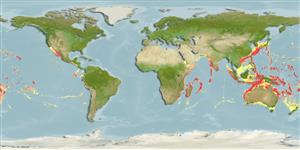Environment: milieu / climate zone / depth range / distribution range
Ecologia
marino benthopelagico; distribuzione batimetrica 1 - 1229 m (Ref. 58302). Tropical
Indo-Pacific: in tropical areas.
Size / Peso / Age
Maturity: Lm ? range ? - ? cm
Max length : 42.0 cm TL maschio/sesso non determinato; (Ref. 94081); peso massimo pubblicato: 663.00 g (Ref. 94081)
Spine dorsali (totale) : 0; Raggi dorsali molli (totale) : 33 - 36; Spine anali: 0; Raggi anali molli: 28 - 30. Lateral line complete. Scales of adults without spines.
Usually found near land masses (Ref. 4388).
Life cycle and mating behavior
Maturities | Riproduzione | Spawnings | Egg(s) | Fecundities | Larve
Smith, M.M., 1986. Bramidae. p. 633-636. In M.M. Smith and P.C. Heemstra (eds.) Smiths' sea fishes. Springer-Verlag, Berlin. (Ref. 4388)
IUCN Red List Status (Ref. 130435)
Threat to humans
Harmless
Human uses
Pesca: scarso interesse commerciale
Strumenti
Special reports
Download XML
Fonti Internet
Estimates based on models
Preferred temperature (Ref.
123201): 8.1 - 19.6, mean 12.3 °C (based on 506 cells).
Phylogenetic diversity index (Ref.
82804): PD
50 = 0.5039 [Uniqueness, from 0.5 = low to 2.0 = high].
Bayesian length-weight: a=0.02692 (0.01566 - 0.04626), b=2.87 (2.72 - 3.02), in cm total length, based on LWR estimates for this species & (Sub)family-body (Ref.
93245).
Trophic level (Ref.
69278): 3.9 ±0.6 se; based on size and trophs of closest relatives
Resilienza (Ref.
120179): Medio, tempo minimo di raddoppiamento della popolazione 1.4 - 4.4 anni (Preliminary K or Fecundity.).
Fishing Vulnerability (Ref.
59153): Low to moderate vulnerability (32 of 100).
